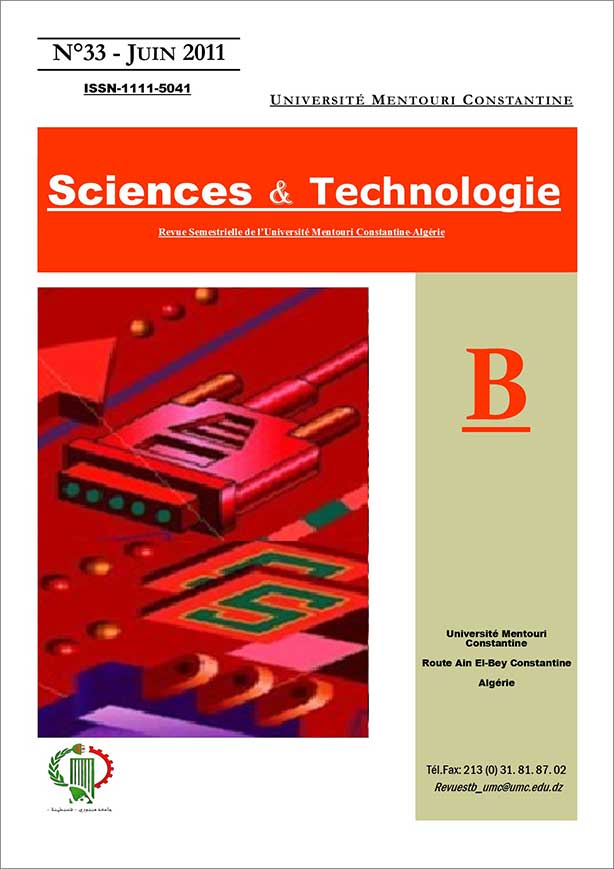COMMANDE SANS CAPTEUR MECANIQUE D’UN MOTEUR ASYNCHRONE BASEE SUR L’APPROCHE MRAS AVEC ESTIMATION SIMULTANEE DE LA RESISTANCE STATORIQUE ET DE LA VITESSE ROTORIQUE
Keywords:
Moteur asynchrone, commande vectorielle, estimation, commande sans capteur, MRAS mutuelAbstract
On présente dans cette étude une méthode qui permet d’estimer la vitesse mécanique et la résistance statorique de la machine asynchrone afin de remédier aux inconvénients de la commande avec capteur et de l’influence des paramètres résistifs dans la commande de la machine asynchrone.
Cette stratégie de contrôle permet de reconstituer la vitesse rotorique et la résistance statorique mutuellement à l’aide d’un observateur adaptatif basé sur la technique MRAS ²Model Reference Adaptive System². L’approche a été validée par simulation numérique pour étudier ses caractéristiques dynamique et statique.
Les résultats des différents testes de simulation ont été effectués pour mettre en évidence les propriétés de robustesse et poursuite de trajectoire, d’un moteur asynchrone triphasé.
References
N.P. Quang and J.A. Dittrich, ” Vector of Three-Phase AC machines”, System Development in the Pratice. Berlin, 2008, pp 107-139.
F. Mehazzem, A. Reama, and H. Benalla, ˝ Sensorless NonlinearAdaptive Backstepping Control of Induction Motor ˝, ICGST-ACSE Journal, Vol. 8, Issue III, (2009), pp. 1-8.
P.D. Marcetic, and S.N. Slobodan, “Speed-Sensorless AC drives with the rotor time constant parameter update,” IEEE Transactions on Industrial Electronics, Vol. 54, No.5, (2007), pp 2618-2625.
J. Holtz, “Methods for speed sensorless control of AC drives,” in Sensorless Control of AC Motors, IEEE Press Book, 1996.
H. Zhang, and M. C. Fu, “Applying model reference adaptive search to american-style option pricing,” IEEE Proceedings of the 2006 Winter Simulation Conference (2006), pp 711-718.
Jie Zhang and T.H. Burton. “New approach to field orientation control of CSI induction motor drive,” IEE Proceedings, Vol.135,Pt. B. No.1; January 1988.
M. Boussak, and K. Jarray “A High-Performance Sensorless Indirect Stator Flux Orientation Control of Induction Motor Drive,” IEEE Transactions on Industrial Electronics, Vol. 53, No. 1, (2006), pp 41-49
M. Cirrincione, M. Pucci, G Cirrincione, and G Capolino “An MRAS Sensorless Technique Based on the MCA EXIN + Neuron for High Performance Induction Motor Drives,” ISSN 0005–1144 ATKAAF AUTOMATIKA, (2005), pp 59-72.
J. V. Amerongen “Adaptive steering of ships a model reference approach,” International Federation of Automatic Control, Automatica, Vol. 20, No. 1, (1984), pp3-14.
V. Vasic and S.V. Savic “Robust MRAS-Based Algorithm for Stator Resistance and Rotor Speed Identification,” IEEE Power Engineering Review, November 2001.
C.M. Liaw, Y.S. Kung and C.M. Wu “Design and implementation of a high-performance field-oriented induction motor drive,” IEEE Trans. Ind. Electron.,vol.38,4, (1991), pp.275-282.
M. Boussak, and K. Jarray ˝ A High-Performance Sensorless Indirect Stator Flux Orientation Control of Induction Motor Drive ˝, IEEE, Trans on Industrial Electronics, Vol. 53, No. 1, (2006), pp. 41-49.
M. Cirrincione, M. Pucci, G. Cirrincione, G-A. Capolino ˝ An MRAS Sensorless Technique Based on the MCA EXIN + Neuron for High Performance Induction Motor Drives ˝, Automatika, ATKAAF, Vol.46, (2005), pp. 59–72.
Z. Zhang, H. Xu, L. Xu, and L. E. Heilman “Sensorless direct field oriented control of three-phase induction motors based on sliding mode for washing machine drive applications,” IEEE Transactions on Industry Applications, Vol. 42, No. 3, (2006), pp694-701.
R. Pena, R.Cardenas, J. Proboste, G. Asher and J. Clare " Sensorless control of a slip ring generator based on rotor current MRAS observer ", IEEE, 36th Annual Power Electronics Specialists Conference, Recife, Brazil, (2005), pp. 2508-2513.
Downloads
Published
How to Cite
Issue
Section
License
Les auteurs publiant dans cette revue acceptent les termes suivants :- Les auteurs détiennent le droit d'auteurs et accordent à la revue
le droit de première publication, avec l’ouvrage disponible simultanément [SPÉCIFIER LA PÉRIODE DE TEMPS] après publication, sous la licence Licence d’attribution Creative Commons qui permet à d'autres de partager l'ouvrage en en reconnaissant la paternité et la publication initiale dans cette revue. - Les auteurs peuvent conclure des ententes contractuelles additionnelles et séparées pour la diffusion non exclusive de la version imprimée de l'ouvrage par la revue (par ex., le dépôt institutionnel ou la publication dans un livre), accompagné d'une mention reconnaissant sa publication initiale dans cette revue.
- Les auteurs ont le droit et sont encouragés à publier leur ouvrage en ligne (par ex., dans un dépôt institutionnel ou sur le site Web d'une institution) avant et pendant le processus de soumission, car cela peut mener à des échanges fructueux ainsi qu'à un nombre plus important, plus rapidement, de références à l’ouvrage publié (Consulter The Effect of Open Access).

